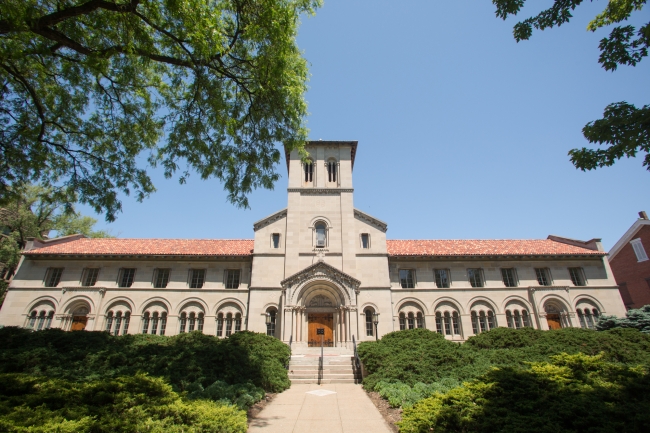You have /5 articles left.
Sign up for a free account or log in.

Oberlin College
Oberlin College has been showing signs of strain as leaders of the well-off liberal arts college in Ohio seek to close a multimillion-dollar budget deficit driven by lower-than-expected enrollment this year.
The strain became evident most recently when The Oberlin Review, the college’s student newspaper, obtained and published a letter written this summer by two faculty members objecting to a salary freeze. The letter, which the student newspaper published Friday as Oberlin’s Board of Trustees was scheduled to meet, said it is “inadequate and depressing that neither the board nor the administration has the leadership or imagination to address this crisis in any way other than by eliminating raises for faculty and staff.”
But the publication of the faculty letter was just the latest in a string of moves by a college grappling with a structural budget deficit. A group of trustees tasked with examining Oberlin’s financial model recently found that the institution -- which includes both a college of arts and sciences and a prestigious conservatory -- relies too heavily on cash from gifts. It does not draw enough of its cash from charging students for tuition, room and board, according to a letter publicly posted in October by Chris Canavan, the chair of the Oberlin Board of Trustees.
Oberlin will seek ways to reduce spending in the short term, Canavan wrote. That will allow it to develop long-term strategies like broadening its appeal to college-bound students, raising money through a new comprehensive campaign, offering early retirement plans and placing stricter conditions on funding for large capital projects.
“The conclusion may seem self-evident, but it’s important nevertheless: we can’t stop appealing to generous donors, we need to find ways to boost our operating revenues and we have to reduce our cash needs where possible,” Canavan wrote.
Canavan, who became board chair in July, is one of several new leaders at Oberlin. Marvin Krislov departed the Oberlin presidency this summer after a decade in the job and became president of Pace University. Carmen Twillie Ambar, formerly president of Cedar Crest College, took over as Oberlin president. Oberlin also has a new vice president and dean of admissions and financial aid, Manuel Carballo.
Nonetheless, October wasn’t the first time Canavan had written about taking measures to shore up Oberlin’s finances. In June of this year, he wrote that Oberlin’s budget for 2017-18 had been dealt “an unexpected blow” because the incoming class would be smaller than expected and fewer students were returning for the upcoming academic year. Oberlin faced a deficit of approximately $5 million, even though it had already reduced budgets across the institution for the upcoming year, Canavan said in an email to faculty and staff that The Oberlin Review published in September.
In response to the enrollment and budget issues, the board approved a plan to hold nonunion salaries at current levels for the coming year, Canavan said in the June email. Doing so would not eliminate the deficit but would make a significant difference without cutting essential services and positions.
Not all faculty would agree with that assertion. Some have argued a pay freeze will lead to a loss of talent at Oberlin as professors pick other, better-paying jobs. Such a trend would hurt educational quality, an essential service for a college.
The board also asked administrators, faculty and staff members to find ways to shrink the structural deficit by bringing in more revenue or cutting spending. The goal laid out was to cut 5 percent of the cumulative budget over the coming 10 years.
“The enrollment shortfall is a sign that Oberlin’s long-term financial model must change with the times,” Canavan said in the June email. “The cost of running institutions like Oberlin gets more expensive every year, while the pool of high school graduates, which grew steadily beginning in the mid-’90s, will stay flat over the next decade. We must spend the next few years making important decisions that will ensure Oberlin’s financial strength well into the future. These decisions must be made thoughtfully and with broad consultation.”
The letter did not detail exactly how much the college’s enrollment had slipped. But Oberlin’s Office of Institutional Research lists 2,827 undergraduates enrolling in 2017, down from 2,895 in 2016. The 2017 enrollment is the lowest level of undergraduates reported since 2,762 in 2007.
First-year enrollment fell at both the conservatory and the college of arts and sciences. Applications rose at the conservatory by 135, to 1,396, in 2017. The conservatory admitted only 28 percent of those applications, its lowest level since 2013. It enrolled 120, down 19 from last year’s class as its yield rate slipped by four percentage points year over year to 31 percent.
At the college of arts and sciences, applications fell sharply, by 891 to 6,366, after setting a record in 2016. The college admitted a larger share of its applicants, 37 percent, than it had since 2009. About 27 percent of those applicants enrolled, the lowest yield rate since 1996. The college’s resulting freshman class numbered 644 in 2017, the lowest level since 2007.
(Dual-degree students applying, admitted and enrolling in both the college and conservatory are counted twice in the statistics above. A total of 36 dual-degree students enrolled in 2017, about the same number as in recent years.)
This spring, Oberlin reported admissions had only declined slightly. No one was available for an interview to discuss admissions Monday.
Oberlin provided a statement referencing the fact that expenses grow every year and saying the college will use broad consultation to make important decisions to set it up for the future.
“In short, some difficult decisions will need to be made, but we are fortunate to be in a position of relative financial strength and thus have the capacity to make careful and strategic choices,” the statement said. “Following this exercise, Oberlin will be well positioned for the long term.”
Oberlin had the 117th-largest endowment in the country in the 2016 fiscal year, according to the most recent study of endowments published by the National Association of College and University Business officers and the nonprofit asset management firm Commonfund. Oberlin’s endowment totaled $770.2 million, giving it an endowment value per student of more than $261,000.
To many liberal arts college leaders, an endowment of that size would be a dream. But the endowment had dropped sharply in market value, by 7.5 percent year over year -- a significant issue for an investment that is intended to last into perpetuity.
In its statement, Oberlin also pointed to the fact that the number of high school graduates across the country is not expected to grow in the coming decade.
Ohio has gone from being a net exporter of college students to a net importer, said C. Todd Jones, president and general counsel at the Association of Independent Colleges and Universities of Ohio. Oberlin is an institution that draws many students from out of state, although that doesn’t necessarily mean it is destined to see an enrollment decline.
“Among my members, we have slightly shrunk in total enrollment over the last five years from about 134,000 to about 131,000,” Jones said. “There are different patterns to that, though. Our nursing-only colleges are growing; Case Western Reserve and the University of Dayton have grown. We also have colleges that have conscientiously shrunk.”
Still, Oberlin is in a part of the country where many institutions are expected to struggle with enrollment. Located about 35 miles to the southwest of Cleveland, it is anchored firmly in the Rust Belt. And Ohio is projected to have fewer graduating high school students in coming years, as are many states in the Midwest. But the college has long seen itself as one that recruits nationally and internationally with its strong academic reputation.
Conservative news outlets have delighted in Oberlin’s struggles. The college is generally considered one of the most liberal institutions in the country, and it is regularly the target of conservative media, some of the more extreme of which have attributed the college’s enrollment declines to politics. But they provided little in the way of firm evidence to support that link.
Nonetheless, Oberlin has found itself at the center of several politically charged events of late. The Associated Press recently reported that Oberlin has been sued by bakery owners who accuse the institution and a dean of slandering their bakery as a racist establishment following a shoplifting case in 2016 -- a charge the institution and dean denied. This fall, the college also put in place a policy under which it will not send out email notifications about hateful fliers unless there is suspicion of immediate danger or a larger pattern.
National politics aside, Oberlin’s plan was clearly not to shrink this year, at least to the degree it has. So the cost-cutting moves it has put in place have rankled some faculty members.
Chris Howell, a professor of politics, and Kirk Ormand, a professor of classics, wrote the July letter that The Oberlin Review published last week. Addressed to Board of Trustees Chair Canavan, it argues that the current pay freeze runs counter to moves Oberlin has made in recent years to raise compensation.
In 2013, the board approved a resolution intended to raise faculty compensation to a median level among a group of 16 colleges, they wrote. From there, plans were put in place to increase salaries over five years by creating salary pools of 4 percent annually, which was intended to match average increases among peer colleges, and by adding $400,000 to the pools each year in order to raise relative compensation.
Achieving competitive compensation was written into Oberlin’s strategic plan, the professors wrote. The strategy was working, only to be cut short after three years, they argued.
“Faced with a structural deficit that some people on the board have been well aware of for many years, and with a short-term deficit in next year’s budget of $5 million, the board has taken the only step that they ever seem capable of taking when faced with financial strain: all nonunion salaries will be frozen next year, a move that will not save even one half of next year’s deficit,” they wrote. “The results are entirely predictable, and will be poor. Our salaries will drop to near the bottom of our peer group within two or three years, and we will remain there as a matter of financial strategy. Hiring and retention will suffer. Our best early-career faculty will leave, as several have over the past three years. Morale will plummet.”
The professors declined additional comment Monday.
The pay freeze was not the only cost-cutting move Oberlin has tried in recent years. In 2016 it introduced a voluntary separation incentive program, taking a restructuring charge of $8.4 million, according to its 2015-16 financial report. It also introduced a consumer-driven health plan intended to cut health-care costs.
The financial world has taken notice of Oberlin’s struggles. In October, Moody’s Investors Service changed the outlook on $130 million in Oberlin bonds from stable to negative. In its rationale for the move, Moody’s cited unanticipated enrollment volatility and budget pressures. The college’s projected budget deficit for the 2018 fiscal year is $2.5 million, Moody’s wrote.
Still, the ratings agency kept Oberlin’s bond rating at Aa3, a high investment-grade level. In doing so, it pointed to Oberlin’s strong reputation as a liberal arts college and conservatory, strong fund-raising, and sizable wealth.








